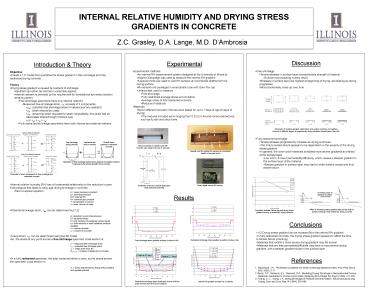Free shrinkage - PowerPoint PPT Presentation
Title:
Free shrinkage
Description:
INTERNAL RELATIVE HUMIDITY AND DRYING STRESS GRADIENTS IN CONCRETE Z.C. Grasley, D.A. Lange, M.D. D Ambrosia Discussion Experimental Introduction & Theory – PowerPoint PPT presentation
Number of Views:28
Avg rating:3.0/5.0
Title: Free shrinkage
1
INTERNAL RELATIVE HUMIDITY AND DRYING STRESS
GRADIENTS IN CONCRETE
Z.C. Grasley, D.A. Lange, M.D. DAmbrosia
Discussion
Experimental
Introduction Theory
- Free shrinkage
- Tensile stresses in surface layer exceed tensile
strength of material - Surface microcracking is likely result
- Stresses in surface layer are highest at
beginning of drying, decreasing as drying
progresses - Microcracks likely close up over time
- Experimental methods
- An internal RH measurement system designed at the
University of Illinois at Urbana-Champaign was
used to measure the internal RH gradient - A special mold was used to cast RH sensors at
incremental depths from the drying surface - RH sensors are packaged in small plastic tube
with Gore-Tex cap - Uniaxial test used to measure
- Free shrinkage
- Fully restrained average stress accumulation
- Average creep of fully restrained concrete
- Modulus of elasticity
- Materials
- Seven different concrete mixtures were tested for
up to 7 days of age (6 days of drying) - The mixtures included w/cm ranging from 0.32 to
0.44 and mineral admixtures such as fly ash and
silica fume
- Objective
- Create a 1-D model that quantifies the stress
gradient in free shrinkage and fully restrained
drying concrete - Theory
- Drying stress gradient is caused by restraint of
shrinkage - Restraint can either be internal or externally
applied - Internal restraint is provided by the requirement
for translational symmetry (section remains
planar) - Free shrinkage specimens have only internal
restraint - Measured free shrinkage strain, ?T, consists of 3
components - ?sh - potential free shrinkage strain (in absence
of any restraint) - ?cr - strain relaxed by creep
- ?el - remaining strain required for strain
compatibility, this strain has an associated
stress through Hookes Law - ?T ?sh ?cr ?el
- Fully restrained shrinkage specimens have both
internal and external restraint
p vapor pressure (constant) p pore fluid
pressure RH internal RH R universal gas
constant T temperature in kelvins v molar
volume of water
Results
p reduction in pore fluid pressure S saturation
factor K bulk modulus of hardened cement
paste k0 bulk modulus of solid hydration
products skeleton vp volume of paste vt volume
of concrete
Conclusions
- 1-D Drying stress gradient can be modeled from
the internal RH gradient - In fully restrained concrete, the drying stress
gradient appears to affect the time to tensile
failure (cracking) - Materials that exhibit a more severe drying
gradient may fail sooner - Materials that are less permeable/diffusible may
have a more severe drying gradient, with a
steeper gradient slope in the surface layer
?T measured free shrinkage strain ?sh
potential free shrinkage strain ?cr creep
strain from B3 Econcrete modulus of elasticity
of concrete
Failed at 3.5 days
Failed at 7.7 days
References
- Mackenzie, J.K., The Elastic Constants of a Solid
Containing Spherical Holes, Proc Phys Soc B 683
(1950), 2-11 - 2. Bentz, D.P., Garboczi, E.J., Quenard, D.A.,
Modelling Drying Shrinkage in Reconstructed
Porous Materials Application to Porous Vycor
Glass, Modelling Simul Mater Sci Eng 6 (1998),
211-236. - 3. Hwang, C.-L., Young, J.F., Drying Shrinkage of
Portland Cement Pastes I. Microcracking During
Drying, Cem and Conc Res 14 (1984), 585-594.
scr stress relaxed due to drying stress
gradient and applied restraint

